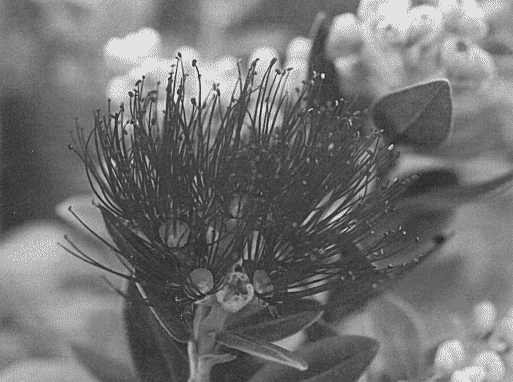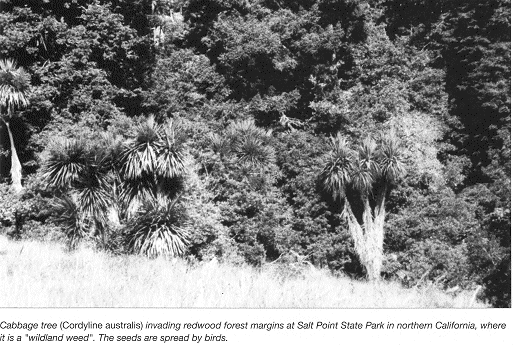|
Our
Native Plant Invaders
Reproduced from an article
by Graham Harris
School
of Natural Resources
Te
Kura Matauranga Rawa Whenua
The Open Polytechnic of New Zealand
From The New Zealand
Garden Journal (Journal of the Royal New Zealand Institute of Horticulture),
Vol. 5, No. 1, June 2002, pp. 6-8.
Graham Harris,
a senior lecturer in the Natural Resources Centre at the Open Polytechnic,
looks at some of our plants that have invaded the landscapes of
other countries. Most
New Zealanders are well aware of the damage that introduced invasive
plants such as gorse, broom, old man's beard, blackberry and many
others have done to New Zealand's landscape — leaving a legacy
that costs the country millions of dollars annually. Few New Zealanders
are likely to be aware that some of our native plants have created
similar problems overseas.
While numerous species
and cultivated varieties of our native plants have been exported
overseas where their beauty and many unique features are appreciated,
a few, finding an environment where their natural competitors are
missing and the climate and habitat to their liking, have become
invasive. They have dominated local plants and damaged ecosystems
by growing faster and reproducing more quickly than in their natural
environment. Some of these plants have been labelled with classifications
such as "alien invasive weeds", "noxious weeds", and "exotic pest
plants of concern".
To put this into perspective,
however, while about 2000 exotic plants have become established
in the wild in New Zealand and more than 200 of these are classed
as weeds that are placing many of our native species under threat,
only a few of our native plants have become invasive overseas and
in only a handful of countries. California in the United States
is one of the places where some of our plants have created problems.
However, as one Californian authority noted — "In general,
New Zealand plants behave themselves in California — not like
those from South Africa and Eurasia". A scientist from the University
of California commented — "the majority of invasive weeds in
California are from Eurasia and North Africa (about 65%) while relatively
few (about 5%) are from Australia and New Zealand."
Other places where New
Zealand plants have become invasive include, the islands of Hawaii,
the south Atlantic islands of St. Helena, and Tristan da Cunha and
the southwestern tip of South Africa. These are some New Zealand
plants that have created problems:
- Karaka (Corynocarpus
laevigatus) is a serious weed pest in Hawaii where it is
described as "an aggressive coloniser that forms a dense shade
which excludes other species, including some endangered native
plants." The karaka was originally planted in the Hawaiian islands
over 100 years ago. It was further spread for re-afforestation
purposes, by broadcasting seeds from aircraft over the interior
of the island of Kaua'i in 1929. It is now present on four islands
and there are major infestations on the islands of Koke'e and
Kaua'i. Seeds are being further spread by birds and there are
serious concerns that infestations will spread to other islands.
Of particular concern is the threat that the karaka poses to the
heau (Exocarpus luteolus), a member of the sandalwood
family and one of Hawaii's most endangered plants. A programme
to monitor and control the karaka has been initiated by Hawaiian
authorities.
- Harakeke or New Zealand
flax (Phormium tenax) was an important source of fibre
for Maori and later in European times formed the basis of a large
fibre industry providing local and export markets with rope, fabric
and other fibre products. At the turn of the century, New Zealand
flax was planted in several countries to establish similar fibre
industries. In the south Atlantic island of St. Helena —
well known as the place where Napoleon died in exile in 1821,
flax was planted widely to provide fibre for making British mail
bags. The economy of the island became almost totally dependant
on flax fibre until the industry collapsed in the 1960s. New Zealand
flax has had a serious impact on the island's ecosystem, which
includes a unique flora of 49 plants found nowhere else in the
world. A paper published by the University of Hawaii noted: "Although
the prehistoric flora of St. Helena is poorly known, one-third
of the known endemic flora is extinct and no vestiges of former
ecosystems remain. New Zealand flax is the most serious pest."
A programme to eradicate flax from the island has been implemented.
New Zealand flax is also an invasive weed on the south Atlantic
islands of Tristan da Cunha where the British authorities have
set up a programme to monitor its spread. In Hawaii, New Zealand
flax was cultivated prior to 1871 and is now classed as an "alien
invasive pest plant." On two islands it has formed dense thickets
that exclude other plants.
- Pohutukawa (Metrosideros
excelsa) has been planted as an ornamental in the Western
Cape province of South Africa for many years and large mature
trees can be seen in the gardens of Cape Town and other towns
of the province where it is known locally as the New Zealand bottlebrush.
In recent years the pohutukawa along with many other introduced
invasive plants has begun to invade sections of the nearby fynbos,
a delicate ecosystem of 71,000 square kilometres, renowned for
its huge range of native plant species. The fine seed of the pohutukawa,
which is produced in vast quantities, is spread by wind and some
areas in the fynbos provide ideal conditions for germination and
growth of the plant. The dense masses of seedlings that are developing
and becoming established indicate the likelihood that impenetrable
stands of trees that suppress native flora will develop. While
no official programme to control the pohutukawa has been initiated
as yet, concerned locals have already begun to remove the plants.
- Ngaio (Myoporum
laetum) is regarded as a serious invasive weed in southern
California's coastal areas and it has also spread south into the
Baja California peninsula in Mexico. In California it is described
as — "a most invasive wildland pest plant" and it is listed
on the California noxious weeds list. It forms dense single species
thickets that expand each year and out-compete other plants. Birds
spread the seeds, greatly enlarging the affected areas. Programmes
to control the plant in California are underway.
- Manuka. (Leptospermum
scoparium) and kanuka (Kunzea ericoides) were first
planted in Hawaii about 70 years ago and they have now infested
several islands where they form thickets that crowd out and suppress
other plants. While they are classed as an "alien invasive pest
plant" they have provided some benefits by stabilising ridge tops
that have eroded following grazing by goats.
- Ti kouka or New Zealand
cabbage tree (Cordyline australis) has infested Salt
Point State Park in Northern California where its growth is encouraged
by the cool foggy coastal conditions. It is listed by the California
Exotic Pest Plant Council as a — "wildland weed of secondary
importance." The council is keeping the plants under close observation
because of the potential for the seeds to be distributed more
widely by birds.
- Kokihi or New Zealand
Spinach (Tetragonia tetragonioides) is a listed noxious
weed in several states in the USA. As the plant is also found
in Asia, Australia and parts of the South Pacific, New Zealand
is not necessarily the source of the initial introduction.
- Piripiri or bidibid
(Acaena) is an invasive weed in California and several
other states in the US and is listed as a noxious weed. In California
it has become naturalised in coastal areas and the California
Department of Agriculture has plans to eradicate it.
- Taupata (Coprosma
repens) is listed as an exotic weed in California although
at present it is not thought to be a threat to wildland habitats.
Taupata is also considered to be a problem in some coastal areas
in Australia although it is not officially classified there as
being an invasive weed.
- New Zealand sedges
Carex buchananii, C. comans, C. flagellifera
and C. testaceae were extensively planted on roadsides
in Tasmania for soil binding and beautification. They were also
sold widely throughout Australia as ornamentals. However, because
they spread rapidly and became invasive, they were proclaimed
serious weeds in 1989.
- Houhere or lacebark
(Hoheria populnea), which is considered to be a potentially
invasive weed in California, became troublesome in the Strybing
Arboretum in San Francisco. Most of the mature trees were removed
and the seedlings are being kept under control. Californian authorities
noted that — "fortunately the plant is not available in the
landscape trade and has not been widely planted."
- Poroporo (Solanum
laciniatum) and karo (Pittosporum crassifolium)
are considered to be "weeds in cultivation" in California. They
are being kept under observation to ensure they do not escape
into the wild.
All of these plants,
with the exception of Acaena and Tetragonia, were
introduced intentionally to the places where they have become invasive,
either as ornamentals or for commercial purposes. Those that have
escaped into the wild have reproduced rapidly, spread their seeds
widely and formed thickets that have excluded nearly all other plants.
In the process they have damaged natural areas, altered ecosystems
and displaced local native species. However, our native plants have
only played a small part in the global problem of invasive species
— an issue that has been identified by the World Conservation
Union as a key global environmental issue for the 21st century.
More Journal Articles
|



